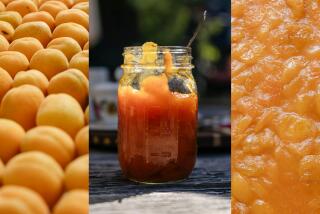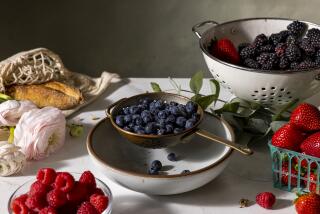Please Don’t Squeeze the Pomegranates
- Share via
When my husband and I bought our house in the Hollywood Hills, its tiny yard was dotted with a sorry collection of unkempt trees--trees that shed dark, purple berries that stuck to our shoes and stained our rugs; trees that spewed white, fuzzy seeds that carpeted the surface of our pool; misshapen pines that dropped needles onto our patio. One stunted specimen inclined alarmingly to one side--the leaning tree of Pisa.
That fall, the stunted, leaning tree produced three pomegranates, and we decided to keep it. In the spring, we had the pomegranate tree replanted and properly pruned. Now it grew straight up, with a graceful, well-proportioned air. The following autumn, it doubled production--six pomegranates--and we felt very smug indeed. A year later, the six-foot tree went ballistic: 39 pomegranates.
When the first one split open in November, revealing its honeycomb of glistening magenta seeds, I knew I had to take appropriate action. “I will make pomegranate jelly,” I declared.
I got out all my canning books and cookbooks and perused the indices. No pomegranate jelly. “Joy of Cooking” advised that pomegranates make good jelly and warned not to bruise the seeds (“for an unpleasant flavor develops”), but offered no recipe.
I was on my own.
*
First, I had to figure out how to separate the pomegranate juice from the seeds in a relatively efficient manner. I did a little experiment, opening up a couple of pomegranates. I peeled the white pith away from the seeds, transferred the seeds into a saucepan, added a little water and brought the mixture to a simmer. When the mixture had liquefied, I poured the juice through a sieve and pressed out the last drops.
I placed the seeds from the other pomegranate into a potato ricer and crushed them, as gently as possible, over a bowl. (Crushing them in a sieve would probably have worked as well.)
Results: The cooked juice had a far better flavor than the fresh-crushed juice, which was bitter and had an earthy taste. “Joy of Cooking” was right.
A word of advice. Don’t try seeding 37 pomegranates if you have any near-term bookings as a hand model. One full week after the ordeal, after much scrubbing, my fingers still bore a slight yellow-brown stain from the pomegranate pith.
Still, it was kind of fun. Some swollen-ripe pomegranates almost burst apart when you score them with a knife; it’s a phenomenon not unlike that of a matron unzipping her girdle. My travail yielded 13 cups of pomegranate seeds, which I deemed worth the trouble.
The next step was to determine whether the juice contained enough natural pectin to jell. One does this by combining a spoonful of cooked, cooled juice with two spoonfuls of isopropyl (rubbing) alcohol. If the mixture contains natural pectin, after a minute flakes of jelled material will form in the juice. (Note: Isopropyl alcohol is poisonous; do not taste this mixture. Discard it safely.) The pomegranate juice showed no evidence of jelling, meaning that it would require pectin.
*
To begin the jelly-making process, I simmered the pomegranate seeds with a bit of water until the mixture had liquefied. Then I poured the mixture through cheesecloth, leaving it to drain overnight. The next day, I followed the directions on the pectin package and cooked the juice in two batches with pectin and sugar, poured it into sterilized jars, sealed them, put them in a boiling water bath for five minutes and began the gloating process, an integral last step in home canning.
Pomegranate jelly is ruby-colored and crystalline. It explodes with tart flavor and is just about the favorite preserve I make. Since early November is the peak season for pomegranates in my neck of the woods, the timing is perfect for holiday entertaining and gift-giving.
And you don’t need to have a tree. When pomegranates are in peak season (late October through early November), they cost about 59 cents apiece, but you can often find them for less. So, the fruit cost runs about $1 per jar--not exorbitant when compared to the price of gourmet preserves and jellies.
POMEGRANATE JELLY
15 to 17 pomegranates, depending on size, yielding about 6 to 7 cups seeds
1 (1 3/4-ounce) package powdered pectin
6 cups sugar
Working over bowl to catch juice, separate pomegranate seeds from pith by scoring each fruit with knife and breaking shell apart, then separating seeds with your fingers.
Transfer seeds and juice to saucepan and add about 1 cup water to keep seeds from scorching. Bring to boil and simmer 20 to 25 minutes, or until membrane around individual seeds has broken down and mixture has liquefied.
Using either jelly bag or sieve lined with double thickness of cheesecloth, pour hot liquid into bag and let juice drip through into bowl or saucepan. Let juice drain 12 hours or overnight. You can press mixture gently with back of spoon to extract more juice, but only very gently; do not squeeze, or jelly will be cloudy. When juice has finished draining, discard pulp and measure juice. There should be about 4 cups. Add up to 1/2 cup water to make exactly 4 1/2 cups.
Sterilize 7 (1/2-pint) jars by boiling in large canning kettle with rack 10 minutes. Leave in canner until ready to use. Place new lids and screw-bands in saucepan full of water. Bring to boil and remove from heat, leaving pan covered.
Pour pomegranate juice into large saucepan and stir in pectin. Bring mixture to full rolling boil over high heat, stirring constantly. Quickly add sugar. Return mixture to full rolling boil and boil 1 minute, stirring constantly. Remove from heat and skim off any foam.
Ladle jelly into sterilized jars, filling to within 1/4 inch of rim. Wipe rims clean and seal with lids and screw-bands. Place jars in boiling water bath canner and boil 5 minutes. Remove jars from canner, set on clean towel and let cool, undisturbed, 24 hours. Makes 7 (1/2-pint) jars.
Each 1-tablespoon serving contains about:
55 calories; 1 mg sodium; 0 cholesterol; 0 fat; 14 grams carbohydrates; 0 protein; 0.04 gram fiber.
* Place mats in pomegranate jelly photo from Bristol Farms Cook ‘N’ Things, South Pasadena.






